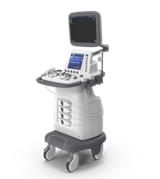Powering Point-of-Care Ultrasound in Acute Care Settings
게시됨 8월 08, 2024 으로 Dr. Simone Baer-Lang
The Need for Reliable Power Supplies as Ultrasound Systems Become More Pervasive
Key Takeaways:
- Ultrasound is a widely used non-invasive diagnostic tool, especially in acute care settings like emergency medicine and trauma.
- Reliable power supplies are crucial for producing high-quality images; poor stability and EMI performance can lead to misdiagnosis.
- Advanced Energy power supplies ensure consistent performance, supporting advancements in imaging software and hardware.
- There is a trend towards portable, battery-powered units to enhance flexibility and reliability in various conditions.
- Power requirements for ultrasound systems vary, with most using a single output power supply between 600 and 1,000 W.
- The design of power supplies, whether integrated with or separate from the battery, impacts the system’s compactness, noise levels, and serviceability.
Power supplies are a crucial component of ultrasound machines. These critical medical imaging machines rely on a stable and reliable power supply to operate effectively, efficiently and produce high-quality images. Efficiency, reliability, form factor and regulatory compliance are some of the important considerations when selecting a power supply. A power supply with poor stability and poor EMI performance can impact accuracy and resolution, leading to poor image quality and potential misdiagnosis.

Fig. 1: An image of a general ultrasound unit.
Advanced Energy power supplies are designed to provide a steady, reliable power source – regardless of the specific cooling mechanism of the power supply, whether fan or convection or conduction cooling. These power supplies ensure that ultrasound devices operate at their peak performance levels, delivering consistently accurate results. Moreover, although ultrasound is a very well established and widely used diagnostic tool, there is still a lot of research and development activity taking place in the imaging postprocessing software. There is also a lot of evolution and progress on the hardware engineering side of the overall system as well as in the transducer area
Power Trend on the Rise
More and more ultrasound manufacturers are looking into how to build their ultrasound units for use with line-power and for use with a battery to enable flexibility and higher portability of their systems, regardless of the location, as well as to support the use in case of unstable or low-performing power-net conditions. The need for proper battery charging and management is usually directly connected to / inside the power supply to support safety, sustainability and standardization.
At the same time, there is another trend emerging to support the increasing desire for improved image quality by further regulating EMI with additional filtering and / or switching frequency adaptations – either by synchronization or spreading spectrum.
However, the growing demand for portability also poses challenges for the compactness of all components, including the power supply, the battery charging boards, the additional filtering, and any other electronic parts needed for the frequency adjustments.
Ultrasound Power Requirements
There are multiple ultrasound systems on the market for different applications and market segments. Power requirements also differ, ranging from 200 W for a very basic ultrasound unit to up to more than 1 kW for a dedicated high-end unit for computing power applications like elastography or height adjustable monitors and printers.
Most ultrasound systems use a single output power supply between 600 and 1,000 W, usually enclosed. If battery charging and discharging are used for the ultrasound system, there are different ways to incorporate them. One option is to install the battery together with the PSU and have a dedicated part for the charging and management functionality built in. Another option is to have the battery connected separately to the PSU, which still has the charging and management functionality. Both ways have their advantages and disadvantages. Having the batteries together with the PSU enclosed offers a very compact, tidy and safe approach. On the downside, the size of the battery is fixed. Whereas having the battery separated might enable an easier service-aspect (for battery replacement) as well as potential cost savings.
Most ultrasound manufacturers prefer a fan-less power supply for their higher-end units to minimize the acoustic noise for the end-user as much as possible. Internally, most of the systems are running on a 12 or a 24 Vdc bus. The bus systems have also become more varied and, next to I²C, SPI and ethernet are now becoming more common as well.
Conclusion
Ultrasound – although it has been around for more than 80 years – is one of the most widely used diagnostic modalities and still offers a lot of research and development opportunities, both in software and hardware.
The power supply is a crucial component of the ultrasound system, which requires not only reliability in delivering the right power at the required output parameters, but its quality has a direct effect on the image quality. The right power supply design ensures that ultrasound systems support the sonographer in doing their job.
Dr. Simone Baer-Lang
Advanced Energy
Simone Baer-Lang is a Senior Strategic Marketing Manager, Medical Power Products at Advanced Energy dedicated for medical Imaging. She joined Advanced Energy in 2023 and has previously held a number of senior roles in product& BusinessLine management, product & technical marketing, and business development in a number of leading medical technology and Imaging companies. Simone holds a Higher Diploma and PhD in Physics from RWTH Aachen University, during those times she was doing research at DESY as well at the Forschungszentrum Jülich.
더 많은 게시물 Dr. Simone Baer-Lang
